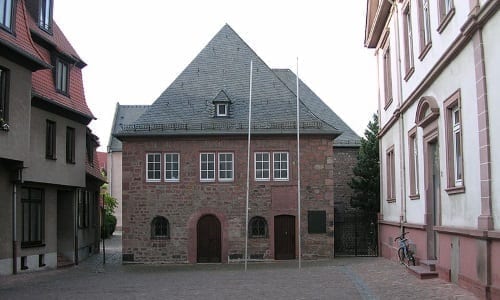
1. Rabbi Shlomo Yitzchaki was born in Troyes, France in 4800 (1040 C.E.).
2. Tradition ascribes his descent from the Davidic dynasty as follows: Rashi was the grandson of Rabbi Elyakim, who was the 31st generation from Rabbi Yochanan the Shoemaker, who was the fourth generation from Rabbi Gamaliel the Elder, who was the son of Rabbi Simon the Nasi, who was the son of Hillel the Elder, who was from the descendants of Shephatiah the son of David, king of Israel.
3. It is related that Rashi's parents were childless for many years. Rashi's father was a dealer in precious stones, and had in his possession a precious stone that the king wanted for his idol. Rashi's father risked death and threw the gem — in which he had invested all his assets, and which would have made him extremely wealthy — from the deck of the ship into the ocean, and acted as if he was weeping over the loss. The king thought the loss was accidental and let him go. According to legend, because of the sacrifice he made, the prophet Elijah appeared to him and promised him offspring that “would illuminate the eyes of Israel”. Rashi was born to his parents in their old age.
4. Rashi studied in the Mainz and Worms rabbinical academies from age 20 to 30. He studied under Rabbi Jacob ben Yakar, Rabbi Isaac Halevi and Rabbi Isaac ben Yehuda, who were disciples of Rabeinu Gershom.
5. Rashi had three daughters. They married brilliant Torah scholars and his grandchildren were among the greatest scholars of their generation. Among his grandchildren were the Baalei Tosfos — Rashbam, Rabeinu Tam and Rivam.

6. Rashi wrote many commentaries on a variety of holy books. He was particularly known for his commentaries on the Bible and Babylonian Talmud. Initially, Rashi published his commentaries in small booklets, and therefore Tosafists call it “the Kuntress” (booklet).
7. Besides his commentary, Rashi was the legal expert to whom questions were sent from all over Europe. His answers which are cited in the contemporary Jewish legal literature as coming from his rabbinical academy (Sifrei D’bei Rashi), are included in Machzor Vitry (the earliest European Jewish prayer book), Sefer Ha’Ora, Issur V’heter L’Rashi and others.
8. Rashi script was widely used in Spain during the Middle Ages. It was used to distinguish between the Biblical text, and Rashi’s commentary but it seems that Rashi never used it.
9. Although Rashi’s commentary is considered as addressing the literal level of the text, no less than 200 commentaries were written on it. The more known ones were written by the Maharal of Prague (Gur Aryeh), Rabbi Eliyahu Mizrachi (HaRe'em), R. Abraham Halevi Bakrat (Sefer Zicharon) and Rav David Pardo (Maskil L’David).
10. The brutal massacres of the Crusades occurred during Rashi's last years. He passed away on Thursday, 29 Tammuz 4865 (1105 CE). His place of burial was lost over the generations.
